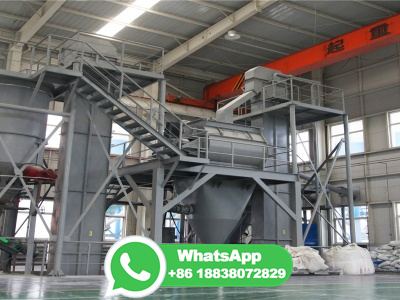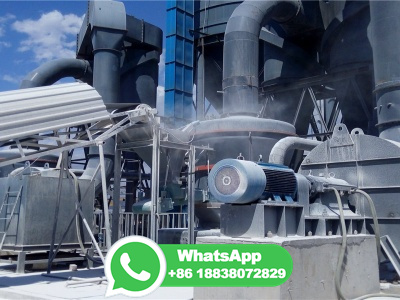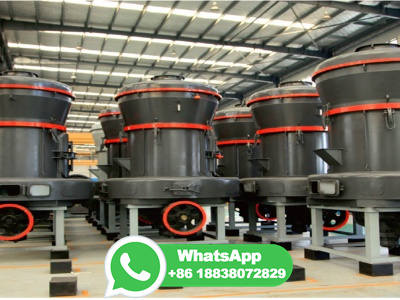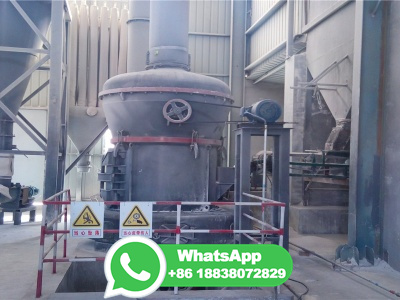
WEBDec 1, 2012 · Due to higher price levels of crude oil, FischerTropsch synthesis (FTS), which converts coal, natural gas, and biomass to chemicals and liquid fuels, has attracted increasing attention in recent ...
WhatsApp: +86 18203695377
WEBBergius coal liquefaction and FischerTropsch synthesis of liquid hydrocarbons were invented and subse quently developed between the years 1910 to 1926. The first step to overcome the lack of ...
WhatsApp: +86 18203695377
WEBThe Fischer–Tropsch process (or Fischer–Tropsch Synthesis) is a set of chemical reactions that convert a mixture of carbon monoxide and hydrogen into liquid hydrocarbons. The process, a key component of gas to liquids technology, produces a petroleum substitute, typically from coal, natural gas, or biomass for use as synthetic lubriion ...
WhatsApp: +86 18203695377
WEBDec 10, 2020 · The Fischer–Tropsch (FT) process is an alternative route to produce petroleum crude equivalent, as this process converts carbonaceous feedstockderived ( coal, biomass, natural gas) syngas to synthetic liquid fuels and chemicals.
WhatsApp: +86 18203695377
WEBThe Fischer–Tropsch (FT) process is a heterogeneously alysed pathway to convert syngas to liquid hydrocarbons. The products are a variety of simple hydrocarbon chains of different lengths, depending on the process conditions.
WhatsApp: +86 18203695377
WEBOct 23, 2006 · The process that uses to turn coal or natural gas into liquid fuels was first developed by two chemists working in Germany in the 1920s: Franz Fischer and Hans Tropsch. The two men died in ...
WhatsApp: +86 18203695377
WEBA technique for the highpressure and hightemperature chemistry of carboncontaining substrates yielded in a patent in 1913. In this process liquid hydrocarbons used as synthetic fuel are produced by hydrogenation of lignite (brown coal). He developed the process well before the commonly known Fischer–Tropsch process.
WhatsApp: +86 18203695377
WEBDec 31, 2007 · The FischerTropsch synthesis process was intensively used during the World War II period for the production of synthetic fuels from coal due to the difficulties felt by some countries to grant ...
WhatsApp: +86 18203695377
WEBOct 3, 2022 · It uses a highly carbonintensive process called FischerTropsch to convert coal or natural gas into refined fuels that would otherwise more commonly be made from petroleum. The process that was ...
WhatsApp: +86 18203695377
WEBCoal gasifiion and Fischer–Tropsch hydrocarbon synthesis together cause a twostage sequence of reactions which allows the production of liquid fuels like diesel and petrol out of the solid combustible coal. The Fischer–Tropsch synthesis took its first serious place in industry in 1935 at Ruhrchemie in Oberhausen.
WhatsApp: +86 18203695377
WEBDec 16, 2022 · At the backend of the process is the Fischer–Tropsch refinery where the material is refined to synthetic jet fuel. ... tar refinery is coloed with the Fischer–Tropsch refinery. 3 The transport fuels are blends of material refined from coal tar and Fischer–Tropsch synthesis and having a high benzene content in the naphtha for .
WhatsApp: +86 18203695377
WEBSep 17, 2018 · This process has four main stages: (1) conversion of natural gas, biomass and coal into syngas; (2) formation of traditional Fischer–Tropsch products (nonselective liquid fuels and waxes); (3 ...
WhatsApp: +86 18203695377
WEBFischer–Tropschmenetelmä on katalyyttinen kemiallinen reaktio, jossa hiilimonoksidia ja vetyä muunnetaan erilaisiksi nestemäisiksi hiilivedyiksi. Tyypillisesti katalyytit ovat rauta ja kobolttipohjaisia, mutta myös nikkeliä ja ruteniumia on käytetty.
WhatsApp: +86 18203695377
WEBMax Planck Institute of Coal Research celebrates 80 years of FischerTropsch Synthesis to make fuels out of coal. December 14, 2005. Because of the decreasing availability of oil, interest has been renewed worldwide in the production of liquid hydrocarbons from carbon monoxide and hydrogen using metal alysts, also known as FischerTropsch ...
WhatsApp: +86 18203695377
WEBJun 20, 2021 · An ironbased alyst allowed liquid fuels containing wax, light/heavy oil, and alcohol fractions to be obtained by the FisherTropsch process at a rate of 5 barrel per day, with detailed ...
WhatsApp: +86 18203695377
WEBA fundamental discovery about the Fischer Tropsch process, a alytic reaction used in industry to convert coal, natural gas or biomass to liquid fuels, could someday allow for more efficient ...
WhatsApp: +86 18203695377
WEBAs a premier example of C1 chemistry, Fischer–Tropsch process is an important reaction in both coal liquefaction and gas to liquids technology for producing liquid hydrocarbons. In the usual implementation, carbon monoxide and hydrogen, the feedstocks for FT, are produced from coal, natural gas, or biomass in a process known as gasifiion.
WhatsApp: +86 18203695377
WEBThe FischerTropsch process is an established technology and already applied on a large scale, although its popularity is hampered by high capital costs, high operation and maintenance costs, and the uncertain and volatile price of crude oil. ... This technology was originally aimed at producing hydrocarbon molecules from coal [37]. The Fischer ...
WhatsApp: +86 18203695377
WEBMay 15, 2024 · Section snippets Materials. In order to study the effect of three synthetic oils obtained from the FischerTropsch synthesis technology of Shanxi Lu'an Group and the emulsion prepared based on one of the oil samples as a collector in actual coal flotation, relevant experimental studies were carried out.
WhatsApp: +86 18203695377
WEBDec 6, 2010 · The FischerTropsch process is currently used to convert coal or natural gas to fuels on a large, industrial scale. ... which is 6 % higher than the existing coaltooil process. Additionally, the ...
WhatsApp: +86 18203695377
WEBSep 1, 2020 · FischerTropsch synthesis for the production of jet fuel. Long chain paraffinic hydrocarbons can be produced in a FischerTropsch (FT) unit using syngas with a H 2 /CO ratio of ~ 2, according to: (1) C O + 2 H 2 →[C H 2]+ H 2 O159 M J / k m o l. Generally, the synthesis occurs at a pressure of 40 – 80 bar, with a cobalt or iron based ...
WhatsApp: +86 18203695377
WEBDec 20, 2012 · Highlights Multiple syngas conversion technologies for hydrocarbon production and hydrocarbon upgrading were integrated into a thermochemical coal, biomass, and natural gas to liquids superstructure. The mathematical modeling of the process alternatives is detailed for each process unit. A simultaneous heat, power, and .
WhatsApp: +86 18203695377
WEBDetailed process simulations, lifecycle greenhouse gas emissions analyses, and cost analyses carried out in a comprehensive analytical framework are presented for 16 alternative system configurations that involve gasifiionbased coproduction of Fischer−Tropsch liquid (FTL) fuels and electricity from coal and/or biomass, with and .
WhatsApp: +86 18203695377
WEBApr 24, 2018 · Extracting, transportation and the using from fossil fuels can damage to the hydrosphere, the biosphere and the Earth's atmosphere. But humans always need to this valuable substance. The production of oil derivatives by means of forest waste and coal through the Fischer–Tropsch process is an appropriate solution for the cleanliness of .
WhatsApp: +86 18203695377
WEBJan 18, 2013 · A Fischer–Tropsch process always forms part of a larger indirect liquefaction facility, which consists of three processing steps. The first step is to convert a carbon source, such as coal, natural gas, biomass, or organic waste, into synthesis gas (syngas). Syngas is a mixture of hydrogen and carbon monoxide, and it is the feed .
WhatsApp: +86 18203695377
WEBAug 1, 2023 · DICL was invented by Franz Fischer and Hans Tropsch in 1923 and is also known as FischerTropsch (FT) synthesis. According to the reaction temperature of FT synthesis, DICL may be divided into lowtemperature and hightemperature indirect coal liquefaction. ... Environmental impact and technoeconomic analysis of the coal .
WhatsApp: +86 18203695377
WEBDec 15, 2022 · The FischerTropsch to olefins (FTO) process is one of the most attractive and promising platform reaction starting with syngas (a mixture of carbon monoxide and hydrogen) derived from nonpetroleum sources (biomass, coal, natural gas) via gasifiion to a alytic conversion of the syngas into olefins [4, 5].
WhatsApp: +86 18203695377
WEBJan 31, 2024 · Fuels for automobiles and feedstocks for chemical industries are conventionally manufactured by refining petroleum. However, gasoline or diesel has also been produced synthetically from various carbonbearing feedstocks such as coal or biomass. The pioneering technology for realizing synthetic fuels is the Fischer–Tropsch .
WhatsApp: +86 18203695377